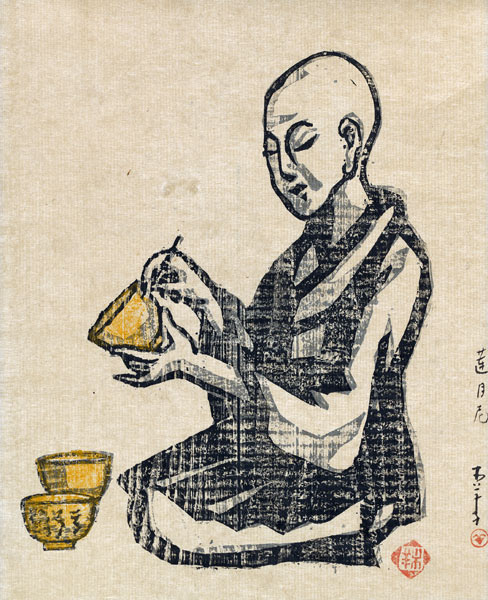The Zen rebels: obscure hermits and existential reformers (part 19). Zen Female Masters - Rengetsu (part 1)
(Image:Morimoto Kiyoko 'Portrait of Rengetsu' hanging scroll [kakemono] 20th century woodblock print)
Nobu is undoubtedly the most interesting of the later Japanese female Zen practitioners. Her story is one of an incredibly fraught, in the early stages of her life, with pain, loss and suffering. As the ever infliction of death being a constant for her. The spectra of losing her children to illness is maintained right up to the point she decides to become Zen Buddhist nun in the mid 1800s. Nobu was born in 1791 and it is thought and probably correct that she was the illegitimate child of a Geisha and the retainer Todou Yoshikiyo. She was then adopted by the Otagaki Family, more so the patriarch layman (who later became a Buddhist priest himself). As per usual, of the many young girls (born of secrecy) of Samurai's would be trained as serving girls, Nobu was sent to Tamba Kameyama castle to which she stayed into her late teens, whilst showing an exceptional ability in calligraphy, music and painting. Nobu was considered beautiful and as a young girl she was courted by many of the young men until Nobu left the castle in 1803. Already very skilled in the arts and calligraphy, in 1804 at the age of 13, is when tragedy begins to impact on Nobu's life, when she lost her adoptive mother and brother. At the age of 17, with the countless men who were interested in having her as their courtesan, she marries, giving birth shortly to her first son in 1808, who later passes away in 1809, a daughter is later born in 1810, once again in its tragic pattern, she dies in 1812. Nobu would have only been in her early 20's, when her husband attempt at procreating for a third child and by documented accounts, a second daughter is born. She also passed away soon after birth in 1815. Her husband soon becomes a heavy drinker, with a tendency to visit prostitutes to which their marriage is quickly dissolved. It is then revealed to Nobu that of the same year with the loss of her daughter, that her former husband also died.
Nobu by her 20's, had lost three children and a husband. The tragedy would be unfathomable, yet there is focus with Nobu, knowing the disadvantages of being a single woman in Japan at the time, she has to survive herself, aware of her skills and beauty. Was also to maintain the direction of meditation, this could be at the point when her adoptive father who was now a Buddhist Zen priest, Nobu begins to utilizes her father's teachings to strengthen resolve – and to continue her detachment. Despite these tragic circumstances of her life up to that point, she takes another husband at the age of 29 in 1819, four years later her last husband passes away from what could be pneumonia. It is said, although not verified completely, that she bore two children either from him or another man, which also subsequently both died from complications from an illness. However these reports maybe a duplication of records from Nobu's early losses. But, it is the fact that death was a constant in her life, which impacts her in a harsher degree when she losses her last husband. This is when Nobu cuts her hair short, renouncing the world and following the teachings of Zen Buddhism, her rapid initiation at the Chion'in Temple - Nobu becomes a Buddhist nun. Given the name lotus (ren/蓮) and moon (getsu/月).
Rengetsu now a resolved Zen practitioner, drawing from her intricislc skills as a calligrapher and poet, with her past, despite its pain, she defines herself as a Zen nun. Rengetsu masters the word, the idea. The stillness, the simplicity of devising meditaton, yet it is seen specifically in her actions. As she becomes one of the greatest Japanese poets and artisan of ceramics of the 19th Century.
"I see it dust
the river wind
then vanish –
fragile snow over water
disappears from my sight."
Rengetsu


Comments
Post a Comment